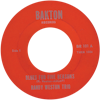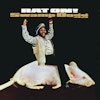In “The Giraffe and the Dandelion,” Abasiama was the tallest giraffe in West Africa. One day, he saw the yellow dandelion transform into a great white ball. The other giraffes gathered around in amazement. Feeling very wise, Abasiama wanted to show off and told everyone that he was going to offer this fuzzy ball to the heavens. When he lifted the dandelion over the treetops, the wind picked up and blew the dandelion apart. Abasiama was ashamed when he lowered the now naked dandelion to show his friends. The smallest giraffe in the pack pointed to the sky and told him not to worry, that the dandelion “snow” was on a journey to spread love and knowledge to all the children of Africa around the world.
As the cradle of civilization was rocking its disparate children into a dream state of bop-soaked African rhythms, a seed of dandelion snow landed on the virtuosic pianist Randy Weston. He felt the heartbeat of Africa and woke from the somnambulistic restraints of pure jazz to heed the call of his motherland and share its sounds.
From childhood, Weston’s father had instilled in him the idea that Randy was “an African born in America.” In turn, he had been pushing the boundaries of exposing the world to a deeper consciousness of African culture since the earliest days of his recording career through his controversial 1960 masterpiece, Uhuru Afrika, a rhythmic hurricane that was so powerful, it was banned in South Africa. He followed that up with Highlife, one of the first American records to feature the popular musical style. After that, it was hard for him to get his music released, so he formed his own label, Bakton, to document the group he had been playing with for three years before they disbanded.
Saxophonist Booker Ervin, trumpeter Ray Copeland, percussionist Big Black, bassist Vishnu Wood, and drummer Lenny McBrowne helped create the LP Randy! Sir Harold Murray was brought on as a special percussionist, “playing a wonderful instrument made of wood and donated by Big Black.” The album is a rich, spiritual mix of Randy’s Thelonious Monk–influenced playing and the African rhythms that had been blossoming in his work. The A-side from the album’s single, “Blues for Five Reasons,” is a traditional blues cut that may have played well in a jukebox. But the B-side, “Congolese Children’s Song,” is where the magic happens. The track locks on to an infectious shuffle beat from the start as Weston breaks out the celeste to add a childlike xylophone-type atmosphere. Big Black falls into step and takes a singsong approach to the vocals. Although the song clocks in at just over two minutes, both Ervin and Copeland get to wail for a few bars and add to the intensifying rapture. And so the six-foot-eight Randy Weston took on the role of giraffe to let the dandelion snow blanket the land with the joyous sound of the Congolese children.


